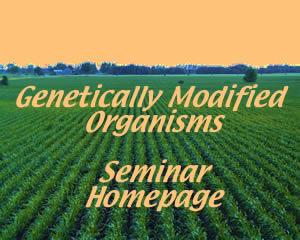






Health Costs and Benefits:
Genetically Modified Crops vs. Traditionally-Bred Crops

image courtesy of University of California San Diego |
Human health is one of the major concerns of companies involved in the genetic modification and breeding of crops. For thousands of years, humans have been selectively breeding and growing crops to become bigger, healthier, and hardier. However, in the past decade or so, technology has advanced in such a way that allows humans to trump evolution. It is now possible to create plants that contain drastically more of a certain protein or vitamin than their wild-type relatives. Plants can be engineered to produce vaccines or human antibodies. Crops can now be planted in places that were previously thought to be incapable of supporting them. |
|
These newfound benefits are not without their costs, however. Many people refuse to eat genetically modified crops, fearful that the new crops may be harmful to their health. This is an ongoing debate, with groups like Greenpeace and Friends of the Earth on one end of the spectrum and biotechnology companies like Monsanto on the other. |
|
Arguments For Genetically Modified Crops
Technology has made it possible to create plants that would never be possible through the mechanisms of evolution alone. Scientists have used this ability to design crops that, in one way or another, will benefit human health worldwide. There are countless examples of this. Researchers aim to engineer crops that are improved over their wild-type relatives in several ways. “Healthier” crops have been designed, containing higher vitamin content. Crops have been engineered to increase the yield per unit area on farms. Still others have been designed to expand the arable area of the earth, making previously barren lands into arable plots for farming.

image courtesy of sdnotill.com
For example, Ingo Potrykus and Peter Beyer “worked for more than a decade” (from newhouse.com) to develop “golden rice,” a transgenic crop that uses genes from a daffodil and a strain of bacteria to stimulate the production of vitamin A in the rice grains. This rice is aimed at curing blindness in 3rd world countries, where rice is a staple. Researchers have produced tomatoes with higher lycopene (an important antioxidant for humans) content than wild-type tomatoes. These tomatoes also had significantly prolonged vine life and juice quality when compared to controls (Nature Publishing Group).
 image courtesy of seattlepi.com
image courtesy of seattlepi.com
|
Tomatoes have been engineered to grow in high salinity areas that would have previously been considered unsuitable for any crops (Nature Publishing Group). These crops aim to solve the problems of malnutrition and world hunger – not as an immediate cure-all, but as one step toward a healthier world. While genetically modified crops differ from wild-type crops with respect to specific traits, they are equivalent in their safety to humans. There has yet to be a case in which a genetically modified crop caused any health problem in a consumer. In fact, genetically modified foods must undergo strict, thorough testing before the food is determined as “safe to eat.” |
image courtesy of thesierraweb.com |
Part of this testing involves a biochemical analysis of the food which would identify any potentially harmful differences in the food. FDA Commissioner Jane Henney, M.D., stands by these crops. “We have seen no evidence that the bioengineered foods now on the market pose any human health concerns or that they are in any way less safe than the crops produced through traditional breeding,” she said (from fda.gov). She adds that “all of the proteins that have been placed into foods through the tools of biotechnology that are on the market are nontoxic, rapidly digestible, and do not have the characteristics of proteins known to cause allergies.”
Arguments Against Genetically Modified Crops
Genetically modified crops are not the saviors that they have built up to be, say opponents. The introduction of novel proteins into an organism make it, by definition, different from the original organism. This difference is seen as the threat to human health. We do not yet fully understand how organisms will respond to the insertion of foreign genes, and this unknown can be frightening. Amplified production of a certain protein also frightens some consumers. This could lead to the possible toxicity of the food, and despite testing, many customers do not trust GMO’s (Greenpeace.org).
Traditionally-bred crops are much safer in these consumers’ opinions. There is little risk of toxicity and little fear of the introduction of a foreign or allergenic protein. Traditional breeding is the natural method of modification in a population, and therefore should be trusted. Traditionally-bred crops won’t solve world hunger, and they won’t spawn a crop that overproduces a foreign vitamin or grows in places where they are not supposed to be, but they are safe (Pariza 2).


